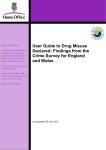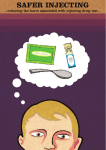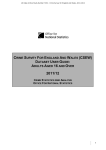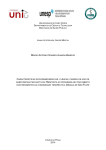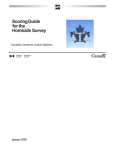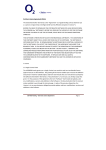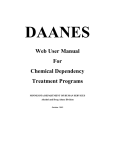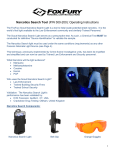Download User guide to drug misuse statistics
Transcript
User Guide to Drug Misuse Statistics Last updated 23 July 2015 Contents Page Section 1 Introduction to drug misuse statistics ..................................................................... 1 1.1 The CSEW as a survey of drug use ....................................................................... 1 1.2 Reliability of CSEW illicit drug use estimates ......................................................... 3 1.3 Limitations of the CSEW as a survey of drug use .................................................. 4 Section 2 Classification of drugs ............................................................................................... 5 2.1 Classification of drugs under the Misuse of Drugs Act ........................................... 5 2.2 Composite drug use measures on the CSEW ........................................................ 6 Section 3 Conventions used in figures and tables................................................................... 8 1 Introduction to drug misuse statistics The annual statistical release ‘Drug Misuse: Findings from the Crime Survey for England and Wales’ examines the extent of, and trends in, illicit drug use among a nationally representative sample of 16 to 59 year olds resident in households in England and Wales. The latest release is based on results from the 2014/15 Crime Survey for England and Wales (CSEW) including trends since the 1996 survey (see https://www.gov.uk/government/organisations/home-office/series/drug-misuse-declared ). As a household survey, the CSEW provides a good and robust way to measure general population prevalence of drug use amongst users contained within the household population. However, estimates from the CSEW must be considered within the context of survey methodology and the operational challenges of obtaining information from respondents on self-declared drug use. The User Guide to Drug Misuse is designed to be a useful reference guide, with explanations of key issues and classifications concerning the production and presentation of the drug misuse statistics. While responsibility for the Crime Survey for England and Wales transferred to the Office for National Statistics on 1 April 2012, the Home Office retained responsibility for analysis and publication of this Drug Misuse publication. This User Guide presents some background information on the CSEW, focusing on the self completion module on drug use. It also describes the classifications of the different drugs asked about in the survey, and explains the measures of drug use described in the Drug Misuse bulletins. For information about demographic classifications and statistical methodology, please refer to Chapter 7 “Classifications” and Chapter 8 “Statistical conventions and methods” of the general User Guide to Crime Statistics for England and Wales, published by the Office for National Statistics. Chapter 2 of the User Guide to the CSEW also includes more detailed background information about the CSEW. 1.1 THE CSEW AS A SURVEY OF DRUG USE Survey methodology The drug misuse estimates from the CSEW are produced from responses to a self-completion module of the survey that is completed at the end of the face-to-face interview (which mainly covers questions on experiences of crime victimisation and perceptions of crime-related issues). Respondents generally complete the drugs module on the interviewer’s laptop by themselves (CASI, computer-assisted selfinterviewing), as this keeps responses confidential from the interviewer, encouraging respondents to answer questions honestly, which is likely to result in better estimates. When complete, answers are encrypted and cannot be retrieved by the interviewer. However, on occasion, respondents may elect for the interviewer to continue administering the questions. CSEW estimates are based on a sample of the population which is considered large for a government household survey. The survey has a high response rate: 70 per cent to the main survey and 97 per cent of those who were eligible for the self-completion module (giving a true response rate of 68%) in 2014/15. The CSEW response rate has dropped to this level from 75 per cent in 2013/14, having remained steady between 73 and 76 per cent in recent years. In light of the fall in the response rate for the 2014/15 CSEW, the ONS published an Assessment of the impact of a lower CSEW response rate. Using a selection of measures collected by the survey, the analysis showed that the fall in the response rate is likely to have a negligible impact on CSEW estimates. It is worth noting that one of the measures included in the analysis was the measure of cannabis use ever in a person’s lifetime. For this measure, the analysis showed that the lower survey response rate may have led to a slight overestimate of this measure, by 0.3 percentage points. However, as the proportion of people who have ever used cannabis in their lifetime is consistently one of the highest proportions measured by the self-completion module on drug use, the effect of the lower response rate on this measure is not visible in the overall trend. 1 User Guide to Drug Misuse Statistics Data are weighted to ensure figures reflect the age and sex distribution of the population under study (adults aged 16 to 59, resident in households in England and Wales). Unless otherwise specified, any reported changes over time in CSEW drug use estimates are statistically significant (see Section 3). The CSEW is able to provide trends over time because the survey has included a comparable selfreport module of questions on illicit drug use since the 1996 survey. Target population The self-completion module is restricted to those respondents aged 16 to 59 years old resident in households. The decision to exclude those aged 60 and over was largely an economy measure, reflecting their very low prevalence rates for the use of illicit drugs among older people. However, those aged 60 and over are asked other questions in the CSEW. While the survey was extended in January 2009 to include children (aged 10 to 15), the CSEW children’s survey includes only a few questions on the use of cannabis. This is because there is already an established National Statistics series giving trends on the prevalence and nature of drug use among 11 to 15 year olds, which is based on the Smoking, Drinking and Drug Use Survey among young people in England. Latest figures for 2014 are published simultaneously with the latest Drug Misuse release, as the two publications together provide an overall picture of drug use. Measures of drug use estimated by the survey The main measure of drug use estimated by the CSEW is the prevalence of drug use in the last year, i.e. in the 12 months prior to interview. Use of drugs in the last year is deemed to be the best indicator to measure trends in recent drug use. The survey also provides estimates of the prevalence of use of an illicit drug ever, that is, at least once in their lifetime. Figures on drug use ever are likely to be influenced by factors such as an ageing population: as people live longer, the 16 to 59 age group becomes more condensed at the upper end, so with time there are likely to be more people who have taken drugs at some point in their lives. In some years, the survey has also included questions on drug use in the last month. These questions are periodically included in the survey, most recently in 2014/15, having last been included in the 2010/11 survey. In the 2014/15 survey they replaced questions on the frequency of drug use, which were asked in other recent years. The questions on last month use measure the recency of drug use, rather than the frequency. However, these estimates are subject to more variation, due to the smaller numbers of last month users, compared with last year users. The removal of questions asking about the frequency of individual drug use and the inclusion of one question asking about the frequency of ‘any drug’ use (and cannabis individually) means that the estimate for the frequency of any drug use for 2014/15 cannot be compared with previous years. This is because it is based on one specific question rather than a composite variable made up of individual questions that ask about frequency of use for each individual drug. Survey timing The figures in the latest release are based on interviews conducted between April 2014 and March 2015. The reference period for last year drug use (where respondents are asked about their drug use in the 12 months prior to interview) will therefore range from April 2013 for the earliest interviews to February 2015 for the latest interviews. Questionnaire development Development of the CSEW questionnaire takes place on an annual basis and aims to reflect emerging issues. This has led to the inclusion (and sometimes subsequent removal) of questions on the use of specific emerging substances. 2 1 Introduction to drug misuse statistics Mephedrone use was first asked about in 2010/11 (use in the last year), in 2012/13 (use ever) and 2014/15 (use in the last month). The questions on mephedrone use have been continued since these survey years. The 2010/11 and 2011/12 surveys asked about the use of Skunk, GBL/GHB, BZP and Spice in the last year, and the 2012/13 survey asked about the use of salvia and nitrous oxide in the last year. These questions were not included in other survey years. In 2014/15, the questionnaire asked about the use of generic, rather than specific, new psychoactive substances (NPS), which are sometimes referred to as ‘legal highs’. These questions are also included in the 2015/16 survey. The 2014/15 survey also included a question on the misuse of prescription-only painkillers (e.g. tramadol, codeine, morphine). This question will be retained for the 2015/16 survey, but the estimate will not be directly comparable to the 2014/15 estimate due to a change in the question phrasing and structure. 1.2 RELIABILITY OF CSEW ILLICIT DRUG USE ESTIMATES Collecting information by using a self-completion methodology with the CSEW increases the reliability of estimates of a sensitive nature, such as illicit drug use, since it allows respondents to feel more at ease due to increased confidence in the privacy and confidentiality of the survey. As a validity check, the survey asks about use of a fictional drug, which identifies those who may not be honest about their experiences of using illicit drugs. The small number of respondents who reported use of this ‘drug’ have been routinely excluded from any analyses. Interpreting estimates and trends Year-on-year prevalence changes are presented using the last year drug use measure, but these need to be interpreted with care and consideration of the following issues. While CSEW estimates are based on a large sample of the population, it should be recognised that levels of drug use are relatively low, so that even when a large section of the population is sampled, the number of users picked up by the survey can be relatively small. Figures and comparisons published in the release are considered to be robust. Where there are insufficient drug users in the sample to enable robust analysis, this has been indicated in the tables that appear in this bulletin. Large sample sizes increase the reliability of estimates for rare acts such as consumption of Class A drugs; however, the range of variability will still be quite large for very rare acts, such as heroin use, because of sampling variability; hence, figures will be liable to fluctuation from year to year. Comparisons have been made with 1996 figures (the start of the CSEW self-report drug use collection) and with survey years a decade ago, to provide trends. However, attention should also be paid to year-on-year changes in the intervening period in order to fully appreciate the patterns of drug use over time. Evidence suggests that use of some types of drug, such as khat, is concentrated in individuals of a specific national origin. CSEW general population estimates may not adequately capture levels of the use of such drugs within such a small subgroup of the population. This is in contrast to usage of other types of drugs, where evidence suggests that their use is not restricted to small subgroups within the population, for example cannabis. Youth boost Between the 2001/02 and 2008/09 CSEW, the survey included a boost sample of young adults in order to improve the accuracy of illicit drug use estimates among 16 to 24 year olds. Estimates based 3 User Guide to Drug Misuse Statistics on surveys conducted prior to the 2011 Census have since been re-weighted to be in line with the 2011 Census population estimate, but the young adult boost weights for survey data prior to the 2006/07 survey could not be reproduced. As a result, the estimates of drug use among 16 to 24 year olds are not based on re-weighted data for the 2001/02 to the 2005/06 survey years. However, changes to other drug use estimates due to the re-weighting were small, so the effect of this on the time-series of drug use estimates among 16 to 24 year olds is likely to be negligible. The youth boost sample does not affect estimates of drug use among adults aged 16-59, as these are based on the core sample only. 1.3 LIMITATIONS OF THE CSEW AS A SURVEY OF DRUG USE Survey coverage As a household survey, the CSEW provides an effective measure of the more commonly used drugs, for which the majority of users are contained within the household population. However, the survey coverage has potential limitations. The CSEW does not cover some small groups, which are potentially important, given that they may have relatively high rates of drug use. Notably these are the homeless and those living in certain institutions, such as prisons. In practice, it may be impossible for any household survey to reach those problematic drug users whose lives are so busy or chaotic that they are hardly ever at home or are unable to take part in an interview. As a result of these possible limitations, the CSEW is likely to underestimate the overall use of drugs such as opiates and crack cocaine, and possibly also frequent cocaine powder use, where the majority of users are concentrated within small sub-sections of the population not covered or reached by the survey. However, this is likely to have only a marginal impact on overall estimates of drug use within the household population. National and regional estimates of the prevalence of opiate and/or crack cocaine use are published by the Public Health England (formerly National Treatment Agency): latest available figures for 2011/12 are online. Unwillingness to report illicit drug use Despite the self-completion methodology of the survey which intends to put respondents at ease by ensuring privacy and confidentiality, issues still exist around willingness to report illicit drug use. An unknown proportion of respondents may not report their behaviour honestly. Hence, estimates of prevalence in this bulletin may be considered lower estimates of the true level of illicit drug use within the general population, even for more commonly used drugs. However, the CSEW provides consistent measures of drug use, obtained in the same way for each round of the survey, irrespective of any strengths or weaknesses relating to coverage or response to the survey. Hence, even if drug use estimates are lower than the true value, comparisons over time remain valid, assuming that unwillingness to report has remained at a similar level over time. Identification of substances used By their very nature, self-report estimates of drug use within a general population sample survey, such as the CSEW, are a measurement of what respondents intended, or believed, they had taken. In reality, particularly with changes in purity of drugs such as powder cocaine, those who have taken illicit drugs will not always be sure about what they have taken. Estimates from the CSEW must necessarily sit alongside other data sources in providing a comprehensive understanding of illicit drug use in England and Wales. 4 2 Classification of drugs 2.1 CLASSIFICATION OF DRUGS UNDER THE MISUSE OF DRUGS ACT The Misuse of Drugs Act 1971 classifies controlled drugs into three categories (Classes A, B and C), according to the harm that they cause, with Class A drugs considered to be the most harmful. This table lists the drugs that respondents were asked about in the 2014/15 Crime Survey for England and Wales (CSEW) and their current classification under the Misuse of Drugs Act 1971. Drugs included in the CSEW trend measures and their classification under the Misuse of Drugs Act (as at July 2015) Classification Drug Class A Powder cocaine Crack cocaine Ecstasy LSD Magic mushrooms Heroin Methadone Methamphetamine Class A/B Class B Class B/C Class C Not classified Amphetamines Cannabis (since January 2009; due to reclassification) Mephedrone (since April 2010) Ketamine (since June 2014) Tranquillisers Anabolic steroids Khat (since June 2014) Amyl nitrite Recent changes in drug classifications Following the Drugs Act 2005, raw magic mushrooms were classified as a Class A drug in July 2005. Prior to this change in the law, only prepared (such as dried or stewed) magic mushrooms were classified as Class A drugs. However, the CSEW does not distinguish between the different preparations of this drug, so the trend in magic mushroom and Class A drug use presented here has not been affected by the change in the law. Amphetamines can be classified as either Class A (when prepared for injection) or Class B (in powdered form). Since CSEW questions do not distinguish between the forms of the drug taken, amphetamine use has not been included in estimates of overall Class A drug use in this report. The CSEW included a question on methamphetamine (which is classified as Class A) for the first time in 2008/09. Similarly, tranquillisers can either be classified as Class B (such as barbiturates) or Class C (such as benzodiazepines). Consequently, Class B and Class C drugs cannot be aggregated reliably because the survey does not identify which specific tranquilliser respondents used. Cannabis was reclassified from a Class B to a Class C drug in January 2004. However, the Government decided to reclassify cannabis as a Class B drug under the Misuse of Drugs Act with effect from January 2009. Reclassification does not affect CSEW estimates, but cannabis is presented as a Class B drug within CSEW reports. 5 User Guide to Drug Misuse Statistics Questions on ketamine were first introduced in the 2006/07 survey. Ketamine was reclassified from a Class C to Class B drug under the Misuse of Drugs Act, with effect from June 2014. Reclassification does not affect CSEW estimates, but ketamine is presented as a Class C drug within CSEW reports up to 2013/14, and as a Class B drug from the 2014/15 Drug Misuse publication onwards, reflecting the change in classification during that interview year. From 2010/11 mephedrone, a new psychoactive substance (NPS) which has been classified under the Act since April 2010, was included in the main trend measures for last year use and in the main trend measures for lifetime use since 2012/13 (when this question was introduced into the survey). Legislation was passed in December 2009 to control the substances GBL/GHB, BZP, Spice and other synthetic cannabinoids. Spice is a brand name of, and generic slang for, various herbal mixtures laced with synthetic cannabinoids. BZP (Benzylpiperazine) is a drug with euphoric and stimulant properties with effects similar to those produced by amphetamines. GHB (gamma-Hydroxybutyrate, an intoxicant and a ‘date rape drug’) has been controlled under the Misuse of Drugs Act as a Class C drug since 2003. GBL (gamma-Butyrolactone) is not active in its own right but is a substance that is converted to GHB by enzymes found in the blood and has a faster onset of effects than GHB itself. Substances such as mephedrone, Spice, GBL/GHB, salvia and other emerging substances are collectively known as new psychoactive substances (NPS), sometimes referred to as ‘legal highs’. Usually, these substances are intended to mimic the effects of ‘traditional’ drugs such as cannabis, ecstasy, or cocaine, and may or may not be illegal to buy. These substances can come in different forms such as herbal mixtures which are smoked, powders, crystals, tablets, or liquids. The 2014/15 survey asked questions about the use of generic, rather than specific, NPS in the last year. Following a review by the Advisory Council on the Misuse of Drugs, which focused on the medical and social harms of khat consumption, it was announced in July 2013 that the government will control khat under the Misuse of Drugs Act 1971 as a Class C drug, from 24 June 2014. Questions on khat were included in the 2010/11 and 2011/12 surveys, removed for 2012/13 and 2013/14, and have been reintroduced for the 2014/15 survey. The category ‘not classified’ indicates that possession of these substances is not illegal but it is an offence to supply these substances if it is likely that the product is intended for abuse. 2.2 COMPOSITE DRUG USE MEASURES ON THE CSEW Within Home Office drug misuse publications, composite variables which amalgamate use of individual drugs are presented; the individual drug use variables that they include are outlined below. Composite drug use variables, 2014/15 CSEW Composite variable Individual drug use variables included Any cocaine Powder cocaine, Crack cocaine Hallucinogens LSD, Magic mushrooms Opiates Heroin, Methadone Any amphetamine Amphetamine, Methamphetamine Cocaine powder, Crack cocaine, Ecstasy, Heroin, LSD, Magic mushrooms, Methadone, Methamphetamine Powder cocaine, Crack cocaine, Ecstasy, Amphetamine, Amyl nitrite, Methamphetamine, Mephedrone Amphetamines, Amyl nitrite, Anabolic steroids, Cannabis, Powder cocaine, Crack cocaine, Ecstasy, Heroin, Ketamine, Khat, LSD, Magic mushrooms, Mephedrone, Methadone, Methamphetamine, Tranquillisers, unknown pills or powders, something unknown smoked, any other drug Any Class A drug Any stimulant drug Any drug 6 2 Classification of drugs Inclusion of specific variables in composite drug measures Individual types of drugs which are specifically asked about in the CSEW are presented in all tables in the substantive part of the release. In addition to these named drugs, respondents are also asked whether they have taken something else in the same time period, that is: pills or powders (not prescribed by a doctor) when you didn’t know what they were; smoked something (excluding tobacco) when you didn’t know what it was; and, taken anything else that you knew or thought was a drug (not prescribed by a doctor). These are included in the composite measure of ‘any drug’, but not presented individually in tables. Questions on glue use have not been included since the 2009/10 CSEW. Analysis of the impact on the CSEW any illicit drug measure and trend in this measure over time showed that removal of glue from the composite measure of any illicit drug use had no overall important impact on this measure. Mephedrone is included in the ‘any drug’ and ‘any stimulant drug’ measures, unless stated otherwise. Prior to the 2014/15 Misuse of Drugs bulletin, two versions of these measures had been presented, with and without mephedrone; in past bulletins it had been excluded from these measures in the context of analysis by demographics. In 2014/15 the measures excluding mephedrone were removed and the demographics back-series were updated to include mephedrone for all past years in which questions on mephedrone had been asked (from 2010/11 onwards for last year use, from 2012/13 onwards for use ever in a lifetime, and from 2014/15 for last month use). Because questions on use of mephedrone ever were introduced two years after the questions on last year use, the estimates of last year mephedrone use from the 2010/11 and 2011/12 surveys are different from the other individual drugs included in the survey, as respondents were not previously asked about their experience of ever using mephedrone. It is not possible to identify what, if any, effect the addition of the lifetime use question in 2012/13 may have had on the last year estimates of mephedrone use, and indeed on the overall measure of any last year drug use, but any effect would be considered to be very small. Stimulant substances Drugs are mainly presented in this report by classification under the Misuse of Drugs Act; however, developing a new composite group (‘Any stimulant drug’) that includes drugs across the legal classification provides an additional useful measure. These types of drugs are used for their stimulant properties and are more likely to be used interchangeably by the same people at similar times and in similar settings. Amphetamines and all forms of cocaine are well known for their stimulant properties, ecstasy is used by clubbers, and amyl nitrite (‘poppers’) deliver a short, sharp high, again often used in clubs. Accounting for concurrent polydrug use when interpreting composite measures Note that caution should be taken in the interpretation of trends in the composite category. Taking Class A drug use as an example, of the people who took Class A drugs in the last year there will be many cases of concurrent polydrug use, i.e. cases where people used more than one drug type in the last year (though not necessarily at the same time). Some people may have taken all of the Class A drugs in the last year, others a combination and some just one. Therefore, if there is an increase in the use of cocaine powder, for instance, there may not necessarily be an increase in the use of Class A drugs. The increase in the use of cocaine powder could occur due to users switching from one drug to another. It is only when there is a significant increase in ‘new’ Class A drug users that a change in use of Class A drugs overall will occur. It is also, of course, possible that users of drugs switch between drugs of different classes. Concurrent polydrug use (use of more than one drug in the last year) is different from simultaneous polydrug use (use of more than one drug on the same occasion, or at the same time). Analyses of simultaneous polydrug use were published in the 2011/12 and 2014/15 Drug Misuse bulletins. 7 3 Conventions used in figures and tables The following conventions are used in the annual drug misuse statistics publication. Table abbreviations ‘0’ indicates no response in that particular category or less than 0.5 per cent (this does not apply when percentages are presented to one decimal point). ‘n/a’ indicates that the question was not applicable or not asked in that particular year. ‘-’ indicates that data are not reported because the unweighted base is fewer than 50. ‘**’ indicates for that the change is statistically significant at the five per cent level. Where an apparent change over time is not statistically significant this is noted in the text. Unweighted base All percentages and rates presented in the tables are based on data weighted to compensate for differential non response. Tables show the unweighted base which represents the number of people interviewed in the specified group. Percentages Row or column percentages may not add to 100 per cent due to rounding. Most tables present cell percentages where the figures refer to the percentage of adults who have the attribute being discussed and the complementary percentage, to add to 100 per cent, is not shown. A percentage may be quoted in the text for a single category that is identifiable in the tables only by summing two or more component percentages. In order to avoid rounding errors, the percentage has been recalculated for the single category and therefore may differ by one percentage point from the sum of the percentages derived from the tables. ‘No answers’ (missing values) All analysis excludes don’t know/refusals unless otherwise specified. 8 © Crown copyright 2015 This publication is licensed under the terms of the Open Government Licence v3.0 except where otherwise stated. To view this licence, visit nationalarchives.gov.uk/doc/open-government-licence/version/3 or write to the Information Policy Team, The National Archives, Kew, London TW9 4DU, or email: [email protected]. Where we have identified any third party copyright information you will need to obtain permission from the copyright holders concerned.











